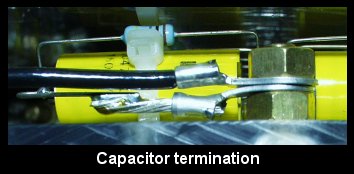MMC Capacitor:
|
||||
|
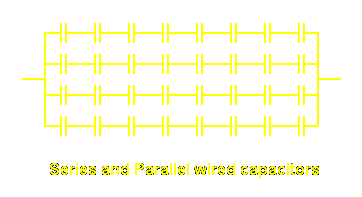 |
|||
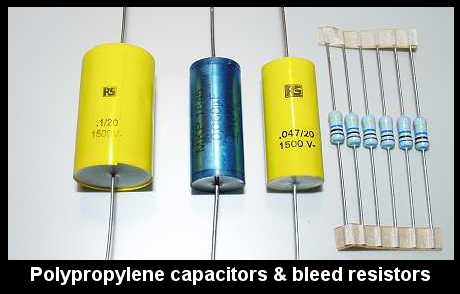 |
||||
| The picture above shows a selection of polypropylene caps and some bleed resistors; values range from 0.1uF to 0.047uF (1500 to 1600VDC), the resistors being 10MegOhm (3500VDC).
Each cap has what is normally considered to be a high voltage rating but in Tesla Coil use 1000V is no longer thought of as high!!. In a primary tank circuit, running from a 10kVAC NST, the capacitor will be exposed to peak voltage levels of 20kVAC, and higher. To allow the use of caps with a rating of only 1kV, you need to share the voltage across multiple (identical) caps in a series wired string. This will split the voltage equally between all the caps, e.g. if 10 caps were used you would have 1kV accross each cap (assumming a 10kV supply).
The capacitors I chose for my MMC have a rating of 1,500VDC. They had an AC rating of 450V. I divided this into 10kV (the output of my NST) to get approx 22. This gave me the number of caps to wire in series. But 22 0.047uF caps in series have a total value of 0.0021uF. I needed a 0.03uF cap for my coil so I had to put 14 strings (of 22 series caps) in parallel. Total number of caps was 308!! After building my MMC, I found that many people were using fewer capacitors in each string. Some were using the DC voltage rating to work out the number required (e.g. 10kV divided by 1,500V gives 7 per string). For my MMC, I could have only used 35 capacitors (5 strings of 7)!! |
||||
|
Series and Parallel wiring of capacitors: What happens to the total capacitance when you wire components in series and parallel circuits?
The value of a single capacitor (Fig.1) is The value of series wired capacitors (Fig.2) is The value of parallel wired capacitors (Fig.3) is An example of series and parallel wired capacitors (Fig.4) (N.B. To calculate for more, or less, capacitors in series/parallel, add, or remove, 'Cn' or '1/Cn' terms, where 'n' is an integer).
|
||||
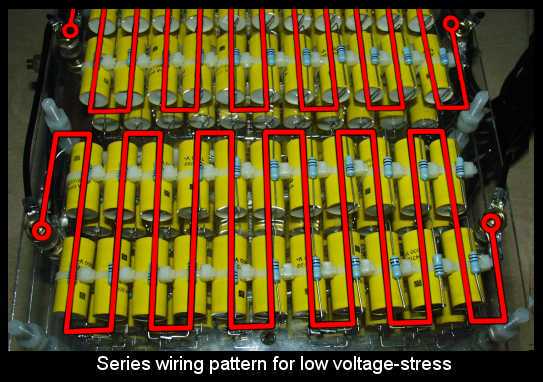 |
||||
| The caps and resistors came from the mailorder company 'RS'.
I chose the 0.047uF polypropylene caps (Part number 114-474) because they were best value for money, i.e. best uF for your pennies, and 10M/0.5W/3500Vdc bleed resistors (Part number 164-8401). |
||||
|
I mounted the capacitors on sheets of plastic (polystyrene, acrylic etc.) by drilling lots of holes and using cable-ties. I managed to fit 3 strings of 22 caps on each layer and then stacked 5 layers to achieve the 14 strings I needed.
|
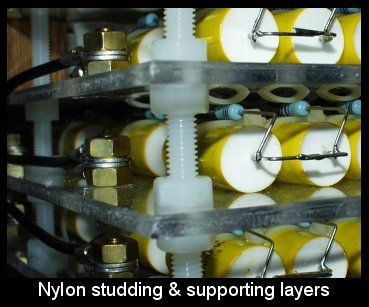 |
|||
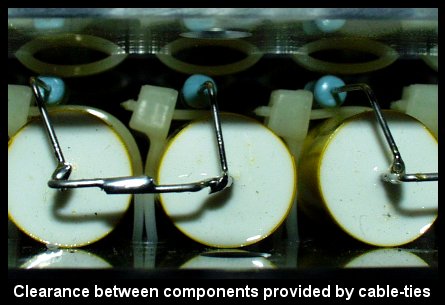
|
|


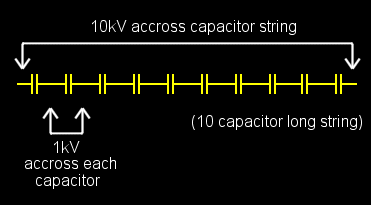
![[capacitors in series & parallel]](graphics/cap_sp.gif)
 or
or 

